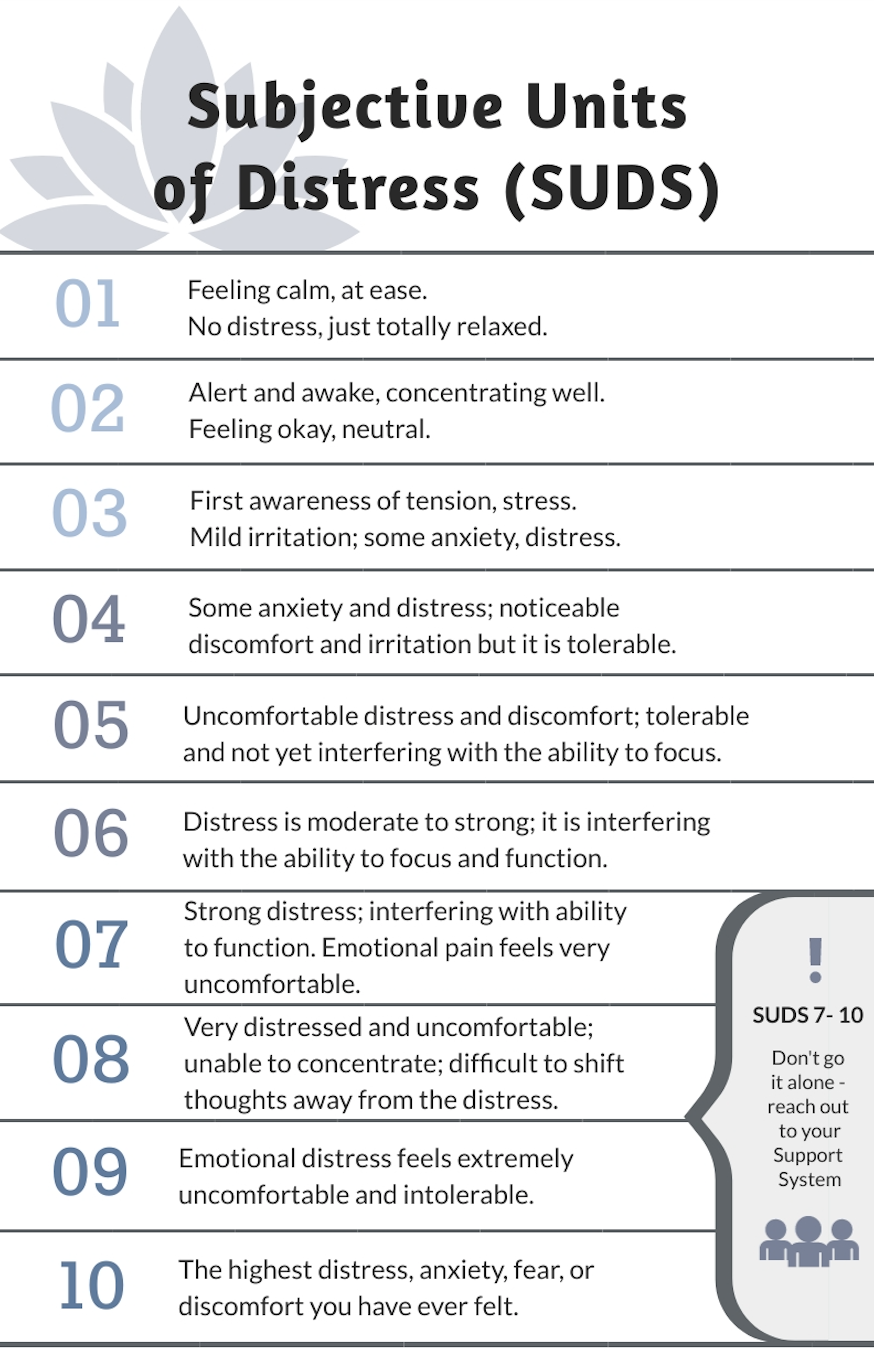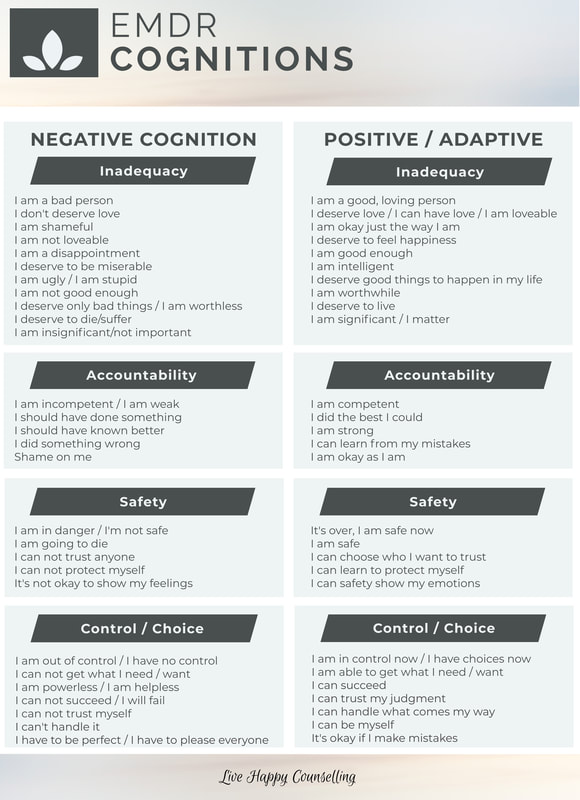|
There are many therapeutic approaches in counselling psychology. In this article, I'll describe Eye Movement Desensitization and Reprocessing (EMDR). Originally developed by Francine Shapiro for use with post-traumatic stress, EMDR is also used with fears, phobias, addiction, and anxiety. It also works to strengthen feelings of calm and confidence. **Please know that no therapy is one size fits all. There are many layers and approaches in counselling psychology and to the complex experiences people have. This information is intended to introduce you to EMDR therapy to inform your expectations prior to starting counselling. The Body Holds EmotionEMDR is a somatic approach to therapy, which means that in addition to exploring thought processes and emotion, we also explore how the body is holding emotion (referred to as “the felt sense" of emotion). When a traumatic event happens, we humans tend to become flooded with emotion, and our brains don’t process/store the memory properly. What happens is that parts of the event (thoughts, emotions, body sensations, images, smells, etc.) stay unprocessed in the brain. This can cause reminders in day-to-day life to activate those unprocessed memories, making it feel as though the trauma is happening all over again. You know in your cognitive brain that it isn’t – but the felt sense of emotion that spikes up so fast makes it feel like danger is real and present. EMDR works with the memories that are causing the present-day distress and “reprocesses” them. The Elements of EMDRHere is a more in-depth look at what EMDR stands for. The Eye Movement is a type of bilateral stimulation (BLS), a core feature of EMDR. The term ‘bilateral’ refers to two sides: eyes moving back and forth in a rhythmic side-to-side pattern. Thanks to research and new technologies, the bilateral stimulation used during EMDR can be visual (eye movements), auditory (sound), or tactile (touch). Bilateral stimulation ensures that both hemispheres of the brain have an active role in memory processing. Bilateral stimulation refers to a back-and-forth rhythmic movement. In EMDR, it can be facilitated with eye movements, sound, or touch. This bilateral stimulation seems to unlock the nervous system and allows the mind and body to process the experience. Your brain does the healing, and you are in control (Parnell, 2014). The therapist can create visual bilateral stimulation by moving their hand back and forth or with a light bar. A light bar is a bar with a light on either end, which pulses one at a time. Your eyes follow the lights, side to side, in a rhythmic pattern, thus the term “bilateral”. Auditory BLS is facilitated with earbuds, with a sound being played which alternates from one earbud to the other. Tactile BLS can be facilitated by tapping rhythmically from side to side. Therapists often use the Thera-Tapper, a handheld device (one 'tapper' in each hand), which uses a gentle vibration - like the vibration a smartphone makes. Bilateral stimulation is a core feature of EMDR because through repeatedly activating the opposite sides of the brain, it harnesses the power of the Accelerated Information Processing Model and aids in releasing emotions that feel ‘stuck’. It can be said that this process mimics REM sleep: when we are sleeping and in the REM stage, our brains have a chance to process the events of the day. In trauma, we know that memories get stuck – they aren't processed or stored like other memories. By using BLS as part of trauma processing, we help our brains finish processing those distressing events. The troubling images and emotions associated with the disturbing/scary/upsetting event are processed while paired with repeated alternating stimulation (BLS). Doing so enables the memory to begin consolidating, the distressing bits feel less potent, and a more peaceful emotional state is achieved. There is a lot of emotion packed into trauma memories. As you read this, you might be feeling worried that if you start working with a past trauma, the level of emotion it evokes might be too much to handle. Your EMDR Counsellor is trained to help you navigate through the process. So, while working through distressing memories does evoke emotion – we honour that by going slowly, keeping our focus narrow, and building up emotion regulation first. Interesting Facts About BLS
Desensitization means that we’re working with the intensity of emotion felt when recalling a disturbing/scary/upsetting event. Desensitization refers to the process of becoming less and less distressed with the memory of an event that was disturbing/scary/upsetting but that is now over. We cannot undo the past or erase the memory of it, but we can learn to turn down the intensity of emotion felt when recalling it. Reprocessing means that some memories of the disturbing/scary/upsetting event weren’t processed at the time the event occurred. There are many brain systems that are involved during trauma, and many more that are shut down, or suppressed, during the event. This means that the traumatic moment isn’t stored in the brain the way a non-traumatic event is stored. In EMDR, reprocessing means that we work with the memory in a way that enables it to feel over. We work with the memory in a very titrated and strategic way, maintaining awareness of the emotion it evokes, the meaning attached to it, and within the context of your strengths. EMDR in Your Counselling SessionThere are eight stages to the process of EMDR therapy. It begins as many therapies do: building rapport, getting a sense of what brings you in for counselling, and a bit about your history. Knowing your story helps your Counsellor understand your needs in counselling and any troubling symptoms that need immediate attention and helps you both collaboratively create a treatment plan. The next stage shifts into preparation, or resourcing. “Resourcing” is the common name for developing emotional coping skills. It involves developing the tools needed for emotion regulation. This phase involves learning to notice and move through strong, overwhelming emotions as they arise. It’s the part of therapy that works with treating the symptoms (the pounding heart sensation of anxiety, excessive worry cycles based on past experiences, sleep disturbance, etc.).
With the ability to regulate emotion and connect with a degree of internal safety developed, we can begin the next stages of EMDR: Assessment and Desensitization. This is where trauma processing begins. Here, we begin by anchoring with your resources and then move into target selection (which just means you choose what the session focus will be). Because I work with trauma, that often means we want to start out with the first traumatic memory or the worst traumatic memory. Wait! Please don’t stop reading and storm off! I know that can sound frightening, but you will be ready for this stage because of all your hard developing and practising emotional coping skills during the preparation stage. Developing and strengthening emotional coping skills is important, because moving into trauma processing too soon could cause you to feel unsafe and emotionally flooded. My job is to help you be present with emotion without feeling over-powered by it. Learning to turn ‘down the volume’ on some emotions as you need to, and ultimately helping you feel safe with the counselling process is an important first step. When your brain and your body can reconcile trauma as a past event, it means you can anchor into the present moment. You shift out of survival mode and can more accurately attest that you truly are safe now.
Emotional Activation (Feeling Triggered)Have you ever noticed that when something in the present moment reminds you of a trauma you experienced, the emotion that arises feels completely raw and overly excessive to the present situation you are in? That is what unprocessed trauma can feel like. There is an amazing brain system we all have called the limbic system. Its sole job is to keep us alive. Experiencing trauma can keep us popping into that limbic system survival mode way too frequently. Constant survival mode living can leave people feeling emotionally reactive (as though we are constantly in fight, flight, or freeze), and emotionally exhausted. The brain just doesn’t recognize that the trauma is over or that you are safe now. That is why counselling is so important for your overall health and functioning. During processing with BLS, emotion becomes less intense. One of the session goals is to keep reducing activation – getting your SUDS number going down so that you are shifting more and more out of distress. As a result of all that emotional processing, you are able to connect with a positive belief, and we install it with BLS (the next stage in our 8-stage model). Instead of the negative belief you started the session with, such as perhaps “I am not enough”, you now get to decide what positive belief is more preferable, (such as “I am worthwhile”, or “I did the best I could”). We link the positive belief with BLS so that when you think about the past experience, you no longer feel so washed over with thoughts of not being enough–and that old negative belief feels distant. The past event really does feel over and anchored in the past and linked with the positive belief. It can take several sessions to reach this point, and the experience will always evoke a degree of emotion (after all, we can't erase the past from having happened). However, the sadness or fear that arises going forward when the memory is recalled will be less intense and will fit the present situation. Cultivating awareness of how we feel emotion in our body is super important. Trauma can often leave people feeling disconnected from their body. They can get caught up in thoughts, because perhaps it feels safer. However, our body still carries all that tension. Maybe it gets experienced in the form of stomach aches or digestive problems, holding the breath or shallow breathing, muscle tension, or a clenched jaw. This disconnection from the felt sense can become so habitual, that people can stop noticing it. But all that tension and unrecognized dis-ease can cause all kinds of health problems. Containment metaphors might be used during sessions, as well as a body scan. The body scan is a super useful tool to strengthen the positive sensations associated with the positive belief, and for identifying any distress still present. The final stage of the session (but not yet the 8th stage of EMDR), is a debriefing of sorts, where we review strategies for anchoring in the present moment, handling emotion as it comes up, and discussing what to expect after the session in terms of emotions percolating and taking care of self between sessions.
The subsequent session typically starts out with an exploration of anything that came up between sessions, and a re-evaluation of thoughts, beliefs, emotions, and sensations connected with the work from the previous session That’s the eighth stage of EMDR, and then the process continues until individuals feel as though they have worked through the pieces they entered into counselling to address. I hope this summary of what EMDR in a therapy session looks like has been helpful. Remember, while we can not erase traumatic experiences from your memory, with EMDR the brain can reconcile it as a past event. We can lessen the intensity of the emotion the memory evokes, as well as the meaning attached to it. We learn to notice when we are shifting into the limbic system and either act to maintain safety or anchor back into the present moment acknowledging the memory as well as our present moment safety.
0 Comments
Your comment will be posted after it is approved.
Leave a Reply. |
AuthorSusan Guttridge is a trauma-informed Master level Counsellor with the clinical designation of Canadian Certified Counsellor (CCPA). She has 20+ years experience providing individual and group therapy. Archives
January 2024
Categories
All
|




 RSS Feed
RSS Feed